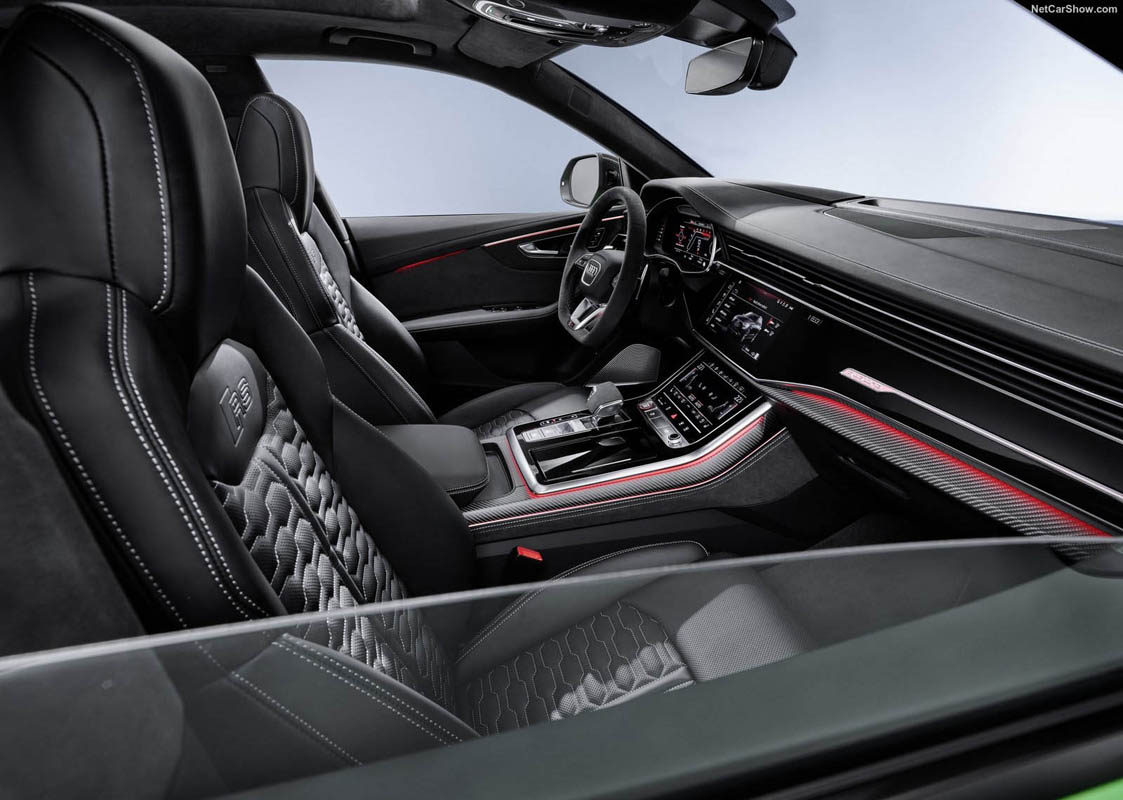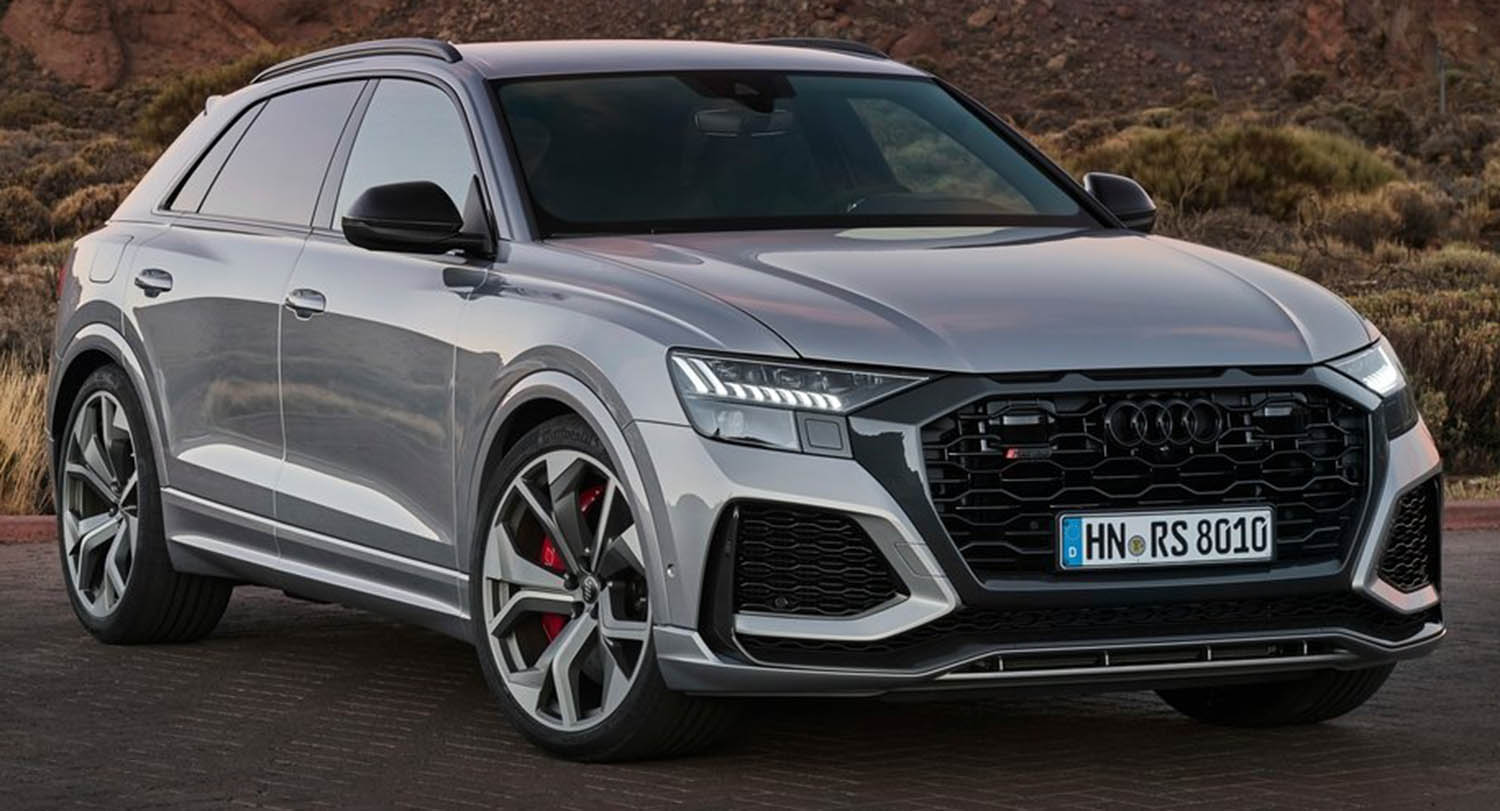
High-performance, variability, everyday usability – the Audi RS Q8 is at the top of its class in the Q product line. The high-performance SUV coupé by Audi Sport stands for outstanding driving performance, enormous variance with regard to design and driver experience, and unrestricted everyday usability.
“For the first time in the 25-year history of Audi RS models, we are putting a large SUV coupé with the genes of a true high-performance sports car on the road,” said Oliver Hoffmann, Managing Director of Audi Sport GmbH. “With its twin-turbo V8 gasoline engine, the Audi RS Q8 is the prestigious spearhead of the RS model family.”
Self-confident: the exterior design
The new Audi RS Q8 impressively showcases its genes as a high-performance sports car. The numerous RS design details enhance the independent character of the new top model of the RS family. Its strikingly self-confident face exhibits an imposing octagonal Singleframe with a black, glossy RS honeycomb grille and large side air inlets.
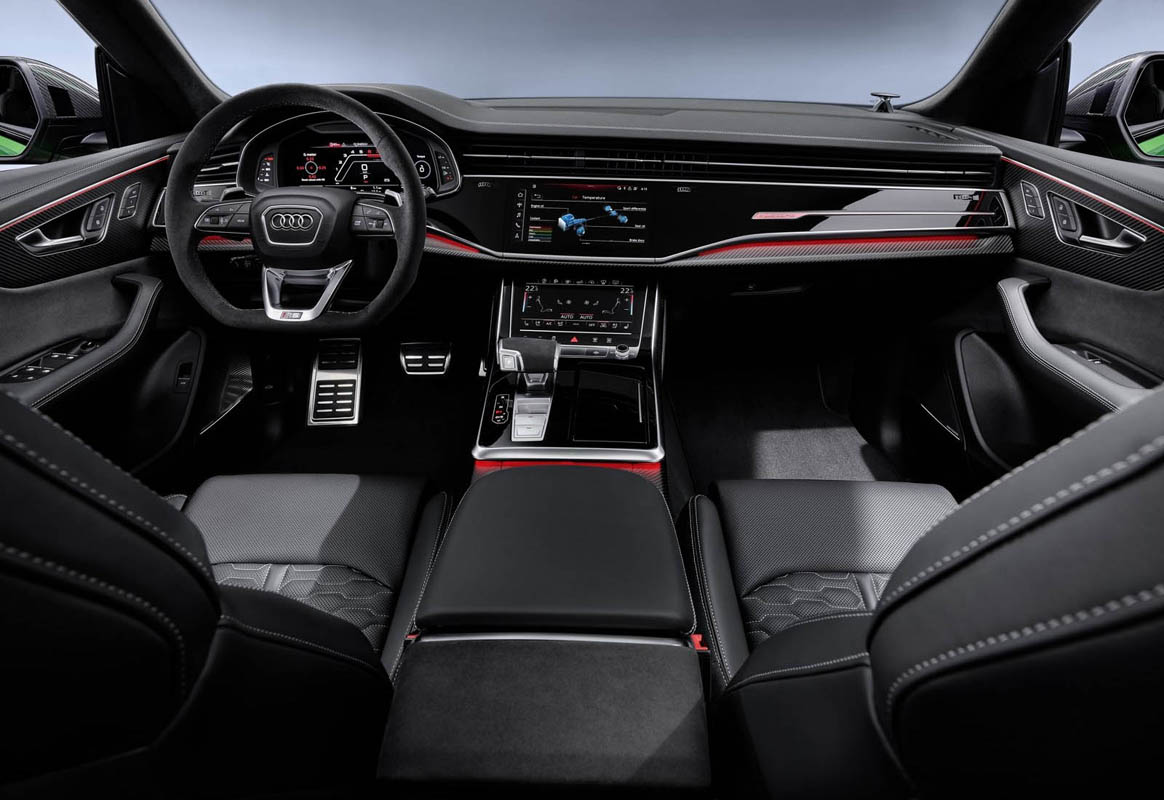
As a unique selling point, the RS Q8 is 5,012 mm (197.3 in) in length and carries a visually encircling RS sill edge in Manhattan gray as standard. RS-specific strips in the body color give the large SUV coupé a greater width – 10 mm (0.4 in) at the front and 5 mm (0.2 in) at the rear. It therefore has the space necessary for a more generous track width.
The RS roof edge spoiler provides a striking finish to the coupé-style, sloping roofline. The characteristic rear light strip and the RS-specific rear apron, including typical RS oval-shaped tailpipes, add a sporty touch for pure performance.
Standard LED headlights illuminate the road with dark-tinted RS Matrix LED headlights available as an option. Here, the three-dimensional signature of the daytime running lights has a digital character, similar to the rear lights.
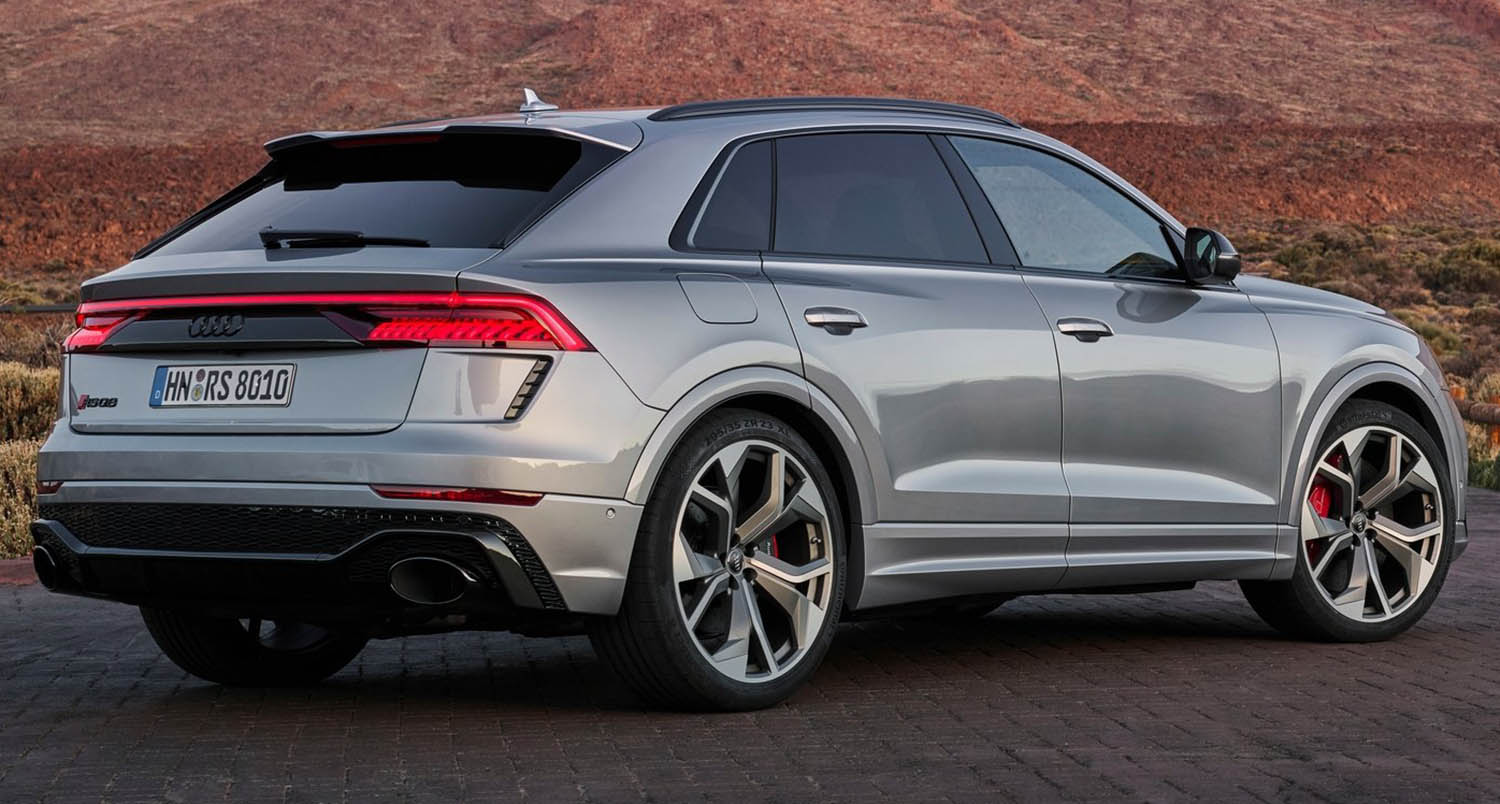
Confident: the drive
441 kW (600 PS), 800 Nm (590.05 lb-ft) torque between 2,200 and 4,500; 1 rpm; from 0 to 100 km/h (62.1 mph) in 3.8 seconds – the 4.0 TFSI in the new Audi RS Q8 delivers a superior RS performance. With the optional dynamic package plus, top speed has been raised to 305 km/h (189.5 mph).
The turbocharged gasoline engine with direct injection produces a full-bodied and sporty V8 sound, which can be adjusted using the Audi drive select dynamic handling system. Thanks to its mild-hybrid system (MHEV) with a 48-volt main on-board electrical system, the V8 power unit combines maximum performance with high efficiency. The cylinder on demand (COD) system is also onboard as another efficiency component. A standard eight-speed tiptronic transfers power to the permanent all-wheel drive quattro.

Adaptable: the suspension
With variable ground clearance, short overhangs, the quattro permanent all-wheel drive and the hill descent control, the new Audi RS Q8 can carry on when paved roads end. The standard adaptive air suspension sport with controlled damping means it is equally at home on the racetrack or an off-road trail. The RS-specific damper tuning allows a particularly generous spread – from comfort-oriented to extremely sporty.
The standard all-wheel steering moves the rear wheels of the new RS Q8 via a high-torque electric spindle drive and two track rods. The steering is perceptibly and directly balanced. Even in the central position, it has a sporty ratio of 13.3:1. During quick cornering, the optional electromechanical roll stabilization (EAWS) minimizes the lateral movements of the body.

The driver can change the character of the high-performance SUV coupé via Audi drive select. There are eight profiles available, including off-road and the customizable RS-specific RS1 and RS2 modes. These can be enabled directly via the new additional RS MODE button on the steering wheel.
The Audi RS Q8 drives on 22-inch aluminum wheels in a 10-spoke star design with 295/40-series tires as standard – the largest ever to be factory-installed on an Audi production model. As an option, 23-inch wheels with an exclusive RS design are available for the RS Q8. The calipers of the RS brake system are painted black as standard but are available in red as an option. With the optional RS ceramic brake, the calipers come in a choice of gray, red or blue.
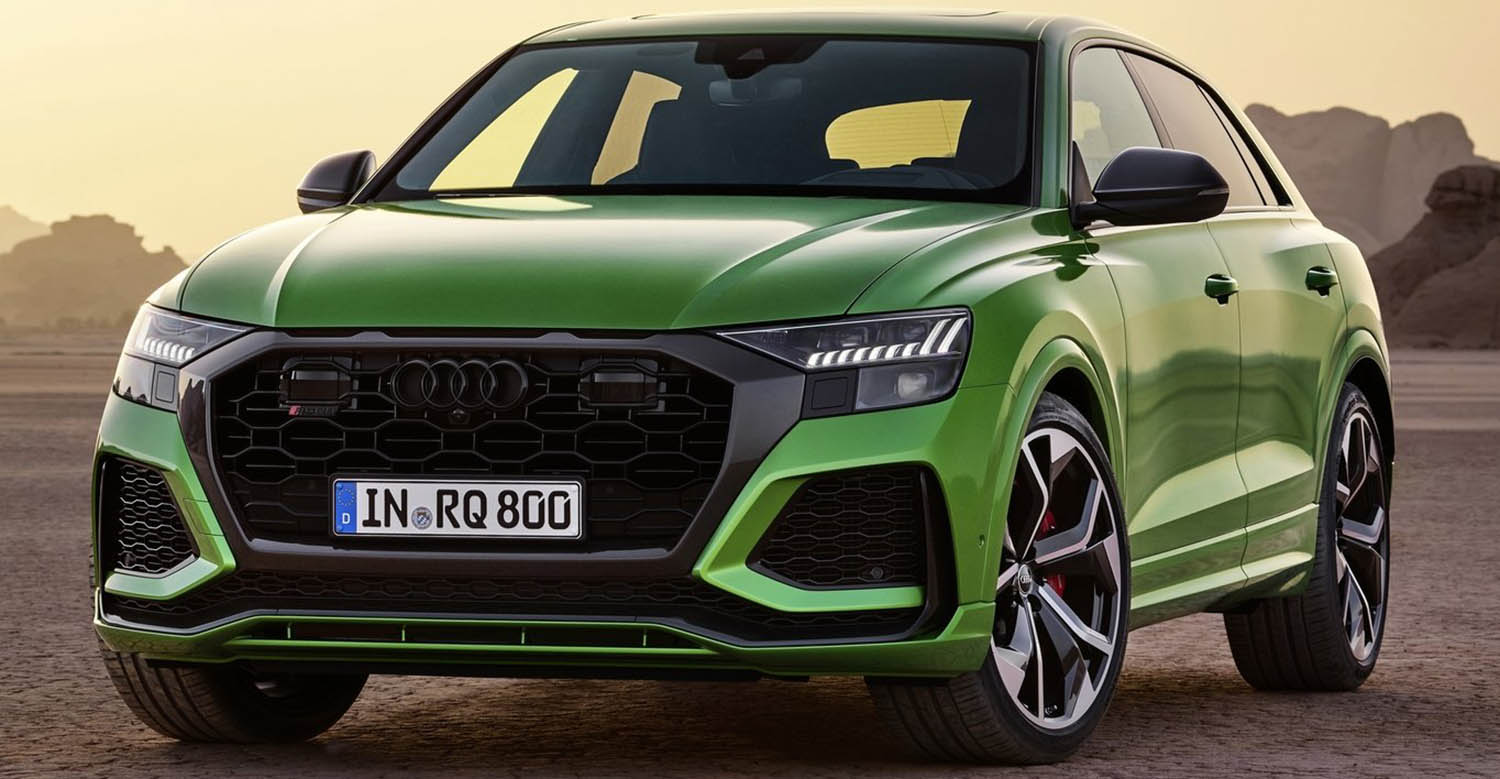
Clear and fully digital: the interior
The interior of the new RS Q8 features a deliberately clean design; the slim instrument panel and the strongly horizontal body line convey a feeling of spaciousness. The central element in the cockpit is the top MMI touch response display. With its black-panel look, it almost dissolves into a large, black surface when switched off.
The driver always has relevant information in view – on the display of the standard Audi virtual cockpit and on the optional RS head-up display. Special RS displays provide additional trip and vehicle data. The shift light display prompts the driver to upshift when the rev limit is reached.

The fully perforated RS sport leather steering wheel flattened at the bottom with shift paddles also includes multifunction buttons. The driver can directly select the new Audi drive select modes RS1 and RS2 via the RS MODE button. This automatically opens the RS-specific displays in the Audi virtual cockpit.
The new Audi RS Q8 successfully combines outstanding sportiness and maximum everyday usability – and the interior is no exception. There is ample space for five. A three-seat rear bench that slides up to 10 cm (3.9 in) is standard. The luggage compartment of the RS Q8 holds 605 liters (21.4 cu ft) as standard, which increases to 1,755 liters (62.0 cu ft) with the rear backrests folded down. An electric tailgate is standard; foot-activated gesture control is available as an option.
Sportiness and luxury are not mutually exclusive. The sport seats with RS embossing fit perfectly into the athletic atmosphere of the RS Q8. Ventilated RS sport seats in Valcona leather with a honeycomb pattern and RS embossing are an even more luxurious option. The Audi RS Q8 is top-notch with respect to voice and connection quality thanks to the Audi phone box and voice-over LTE. The same applies to the Bang & Olufsen Advanced Sound System with fascinating 3D sound.
For the RS Q8, Audi Sport offers comprehensive comfort and connectivity equipment and a large selection of driver assist systems. The RS Q8 will arrive at dealerships in Germany and other European countries starting in the first quarter of 2020. The base price will be EUR 127,000.
Exterior design
Clear contours and athletic and tight surfaces convey the power of the Audi RS Q8, even when parked. Numerous RS design details highlight the independent character of the new top model of the RS family. Its impressive and self-confident face exhibits an imposing octagonal Singleframe with an RS-specific radiator grille and a black, glossy RS honeycomb grille. This, combined with the large side air inlets and the blade in high gloss black, perfectly highlights the athletic character of the 5,012 mm (197.3 in) long SUV coupé from Audi Sport.
The body of the RS Q8 looks well-toned from every viewing angle. This impression is enhanced by the visually encircling RS sill edges, which are designed in Manhattan gray as standard. For a more generous track width, the RS-specific strips in the body color widen the body at the front wheel arches by 10 mm (0.4 in) and at the rear by 5 mm (0.2 in). The large wheels, optionally with a rim diameter of up to 23 inches, additionally emphasize the striking appearance of the RS Q8.
The roof visually spans low over the vehicle body thanks to the frameless doors. The coupé-style roofline slopes and flows into the forward-canted D-pillars and rests against the quattro blisters above the wheel arches. The characteristic rear light strip and the RS roof edge spoiler give an impressive finish. The latter provides downforce on the rear axle for even balance, even at high speeds. The RS-specific rear apron with a diffuser clip in high gloss black and the RS-typical oval tailpipes add a further sporty touch at the rear.
Customers can equip their RS Q8 according to their personal taste. A high variance and a wide range of customization options thus provide the greatest possible creative freedom. The new Audi RS Q8 is available in a choice of nine colors: one solid paint finish and eight metallic or pearl effect shades. The exterior mirror housings come in black as standard with body color, aluminum or carbon available as options. The aluminum and carbon styling packages set precise accents at the radiator grille, blades, diffuser clip and, for carbon, at the rear light strip. In combination with the black and carbon styling packages, the Audi rings and RS logos at the front and rear are optionally available in black. The Audi exclusive range offers numerous other customization options.
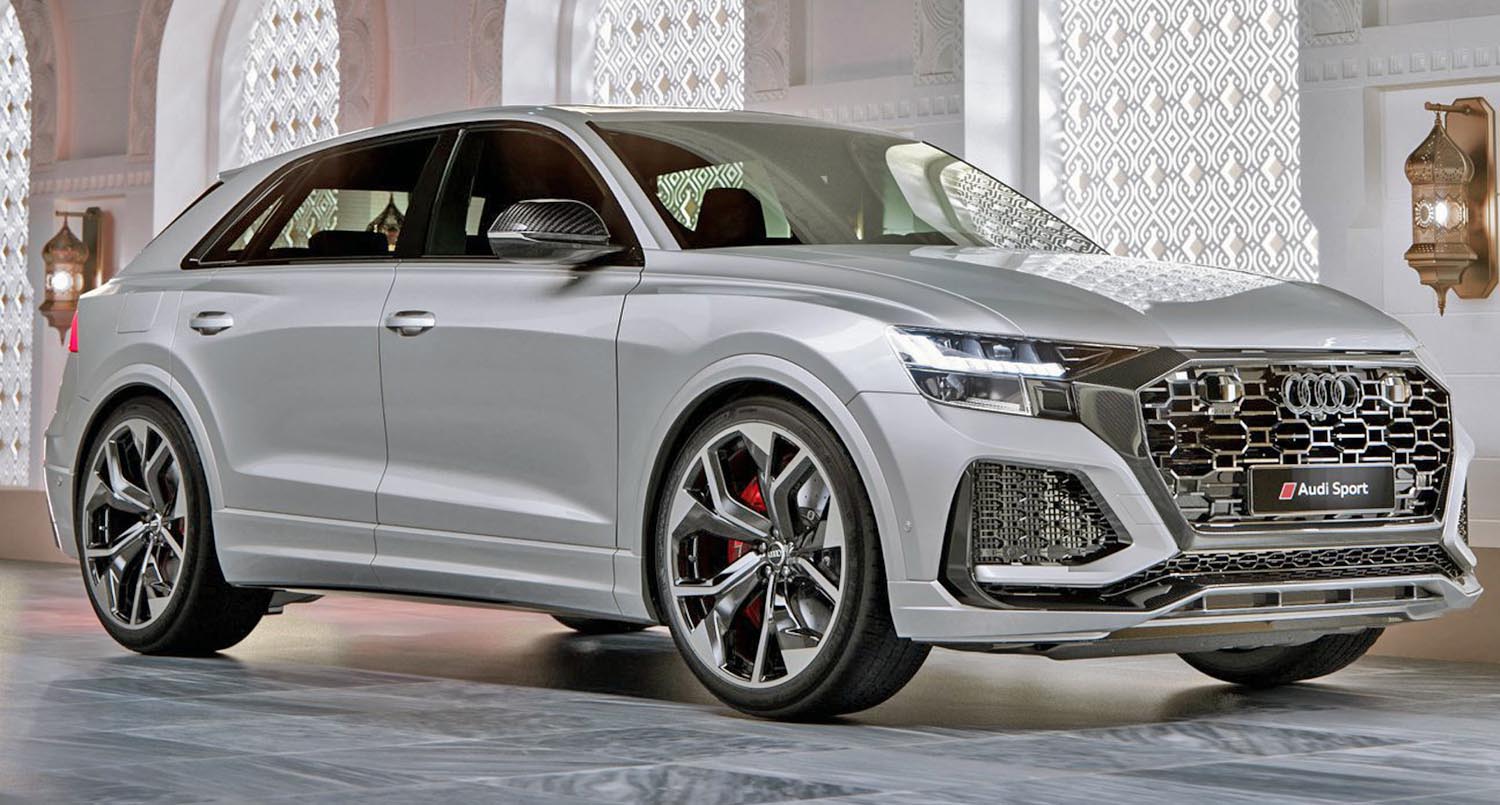
Lighting design
From a distance, the two-piece lights of the RS Q8 look very flat. Integrated into their upper section are the daytime running lights and the low beam, among other functions. The high beam is positioned underneath, slightly darkened and offset to the back. Customers can choose between two different LED headlight configurations.
The optionally tinted RS Matrix LED headlights have a three-dimensional daytime running lights signature with a digital character. The rear lights, each with twelve segments show a similar-looking graphic. They are connected by the striking light strip, which conveys the depth and width.
The S Matrix LED headlights and the rear lights include dynamic turn signals and are showcased by an expressive RS-specific animation when the car is locked or unlocked. Thus, with the leaving home function, i.e. the locking of the SUV coupé, the light points appear to fly horizontally from the outside inward. With the coming home function, this sequence plays out in reverse when leaving the RS Q8.
Engine
441 kW (600 PS) at an engine speed of 6,000 rpm, 800 Nm (590.0 lb-ft) of torque between 2,200 and 4,500 rpm – the 4.0 l (1.06 US gal) V8 in the new Audi RS Q8 delivers impressive RS performance. The turbocharged gasoline engine with direct injection allows the large SUV coupé from Audi Sport to sprint from 0 to 100 km/h (62.0 mph) in just 3.8 seconds or to 200 km/h (124.3 mph) in 13.7 seconds. At 250 km/h (155.3 mph), it is electronically curtailed; with the dynamic package plus, the Audi RS Q8 can drive at up to 305 km/h (189.5 mph). In the WLTP cycle, the power unit certified to Euro 6d-TEMP consumes an average 12.1 liters of fuel per 100 kilometers (19.4 US mpg), equivalent to 276 grams of CO2 per kilometer (444.2 g/mi).
Full sound: V8 firing order and dual exhaust system
The 4.0 TFSI develops a sporty and voluminous sound with its firing order 1-3-7-2-6-5-4-8. As is typical for the RS models, the dual exhaust system features an impressive oval tailpipe on each side. The driver can influence the engine’s sound via the Audi drive select system. The optional RS sport exhaust system with black tailpipe trims offers an even more spectacular sound.
The V8 has a conventional 90-degree bank angle and a displacement of 3,996 cc (bore x stroke: 86.0 x 86.0 millimeters (3.4 in x 3.4 in)). Its crankcase is made of cast aluminum and weighs just 39.1 kilograms (86.2 lb). A 150-micrometer-thick iron coating is applied via plasma spraying to the cylinder working surfaces, which minimizes friction and wear. An electronic valve arranged centrally in the inside V also regulates the map-controlled piston spray nozzles as required for piston cooling.
A fully variable pump drives the oil circuit. It is split into two separate oil galleries – one for the engine block and one for the cylinder heads. This layout ensures a reliable supply of oil even under the extreme lateral and longitudinal acceleration that the Audi RS Q8 is capable of achieving. The variable water pump is used only at 80 degrees Celsius so that the coolant, which has not been flowing so far, heats up quickly. The chains of the valve gear are driven by a geared intermediate shaft. This also drives the water pump. To ensure that the cylinders are filled properly at all times, intake and exhaust camshafts can be adjusted by 50 degrees. Each cylinder bank drives a high-pressure fuel pump for the direct injection, which builds up pressure of up to 250 bar. The injectors, located in the center of the combustion chamber, inject the fuel through seven holes, following special injection strategies depending on the requirements, from cold start to full load.
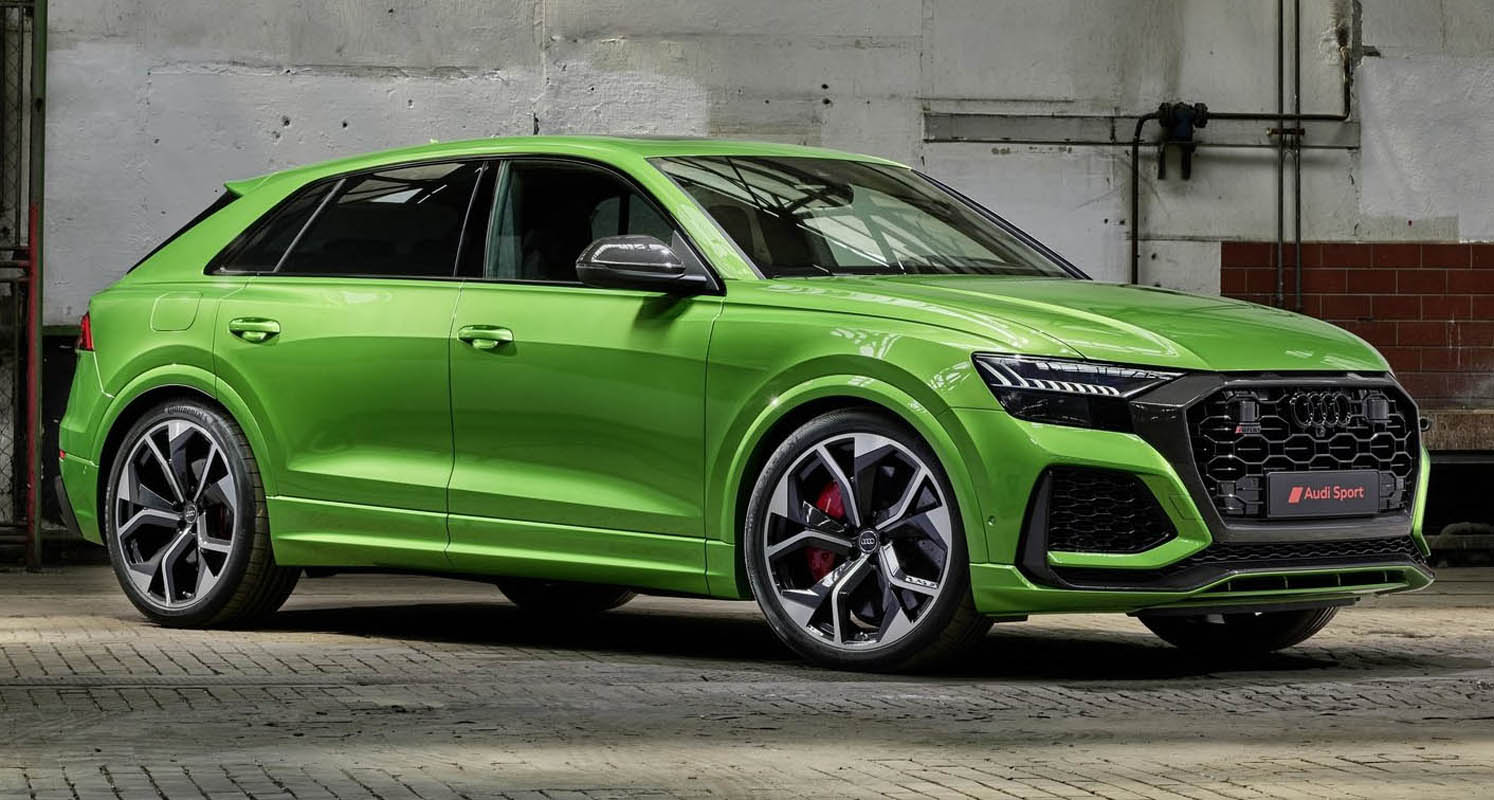
Pure power: the two twin-scroll turbochargers
The immense torque that the 4.0 TFSI already produces at low engine speeds is all thanks to the two twin-scroll turbochargers. Each turbocharger supplies one cylinder bank with up to 1.4 bar of pressure (relative). This high value results in an excellent filling ratio of the cylinders, meaning that more air is available for the combustion of fuel. This results in high engine output and improved efficiency. The cylinder heads have the intake side on the outside and the exhaust side on the inside. The turbochargers and their optimized air-to-air heat exchanger are located in the 90-degree inside V of the cylinder banks rather than in the usual location outside next to the crankcase. This layout enables short gas flow paths with minimal flow losses and spontaneous engine response. Elaborate and effective insulation of hot parts ensures thermally stable conditions in the inside V. The compression ratio is 9.7:1.
Performance and efficiency: mild-hybrid system (MHEV) and cylinder on demand (COD)
The V8 twin turbo in the new RS Q8 combines performance and efficiency. Its mild-hybrid system (MHEV) is based on a 48-volt main electrical system. At its core is a belt alternator starter connected to the crankshaft. During deceleration and braking, it can recover up to 12 kW of power and feed it into a compact lithium-ion battery as electricity. If the driver takes their foot off the accelerator at a speed between 55 km/h and 160 km/h (34.2 to 99.4 mph), the drive management selects one of two solutions depending on the driving situation and the current setting of the Audi drive select dynamic handling system: The new RS Q8 either recuperates or glides for up to 40 seconds with the engine off. The belt alternator starter starts the engine within fractions of a second when the accelerator is actuated. MHEV technology allows start-stop mode from a residual speed of 22 km/h (13.7 mph). The mild-hybrid system is connected to the camera sensors for even greater efficiency. When stopped, the engine starts up while the brake pedal is still depressed as soon as the front camera detects that the vehicle in front of the Audi RS Q8 is beginning to move.
The interplay of the MHEV components improves ride comfort and also has the potential to reduce fuel consumption in everyday driving by as much as 0.8 l/100 km.
The cylinder on demand (COD) system is another weapon in the vehicle’s armory when it comes to efficiency. At low through intermediate load and speed, it deactivates cylinders 2, 3, 5 and 8 in the high gears by switching off injection and ignition and allows the intake and exhaust valves to be closed at the same time. During four-cylinder operation, the operating points of the active cylinders thus shift to higher loads and map points with better efficiency, while the deactivated cylinders run largely loss-free, like gas springs. They are reactivated instantly when the driver presses the accelerator pedal. Each switchover takes mere milliseconds and is virtually undetectable.
Transmission
As standard, the 4.0 TFSI is coupled to an eight-speed tiptronic with optimized switching times and launch control function. When coasting and rolling out, a clutch in the central transmission opens and interrupts the drive shaft. With its electric oil pump, the tiptronic can nevertheless engage the gear required for restarting while coasting with the engine switched off. Special ventilation allows off-road use.
The V8 power of the 4.0 TFSI goes beyond the permanent all-wheel drive quattro, onto the road. Constructed as a planetary gear, the purely mechanical center differential normally distributes the drive forces to the front axle and rear axle at a ratio of 40:60. In the event of slip, more drive torque automatically goes to the axle with the better traction. Up to 70 percent can be directed to the front wheels or up to 85 percent to the rear wheels.
The wheel-selective torque control perfects the safe and agile handling of the new RS Q8. During dynamic cornering, the optional quattro sport differential distributes drive torques between the rear wheels as required. This active torque vectoring improves traction, stability and dynamics.
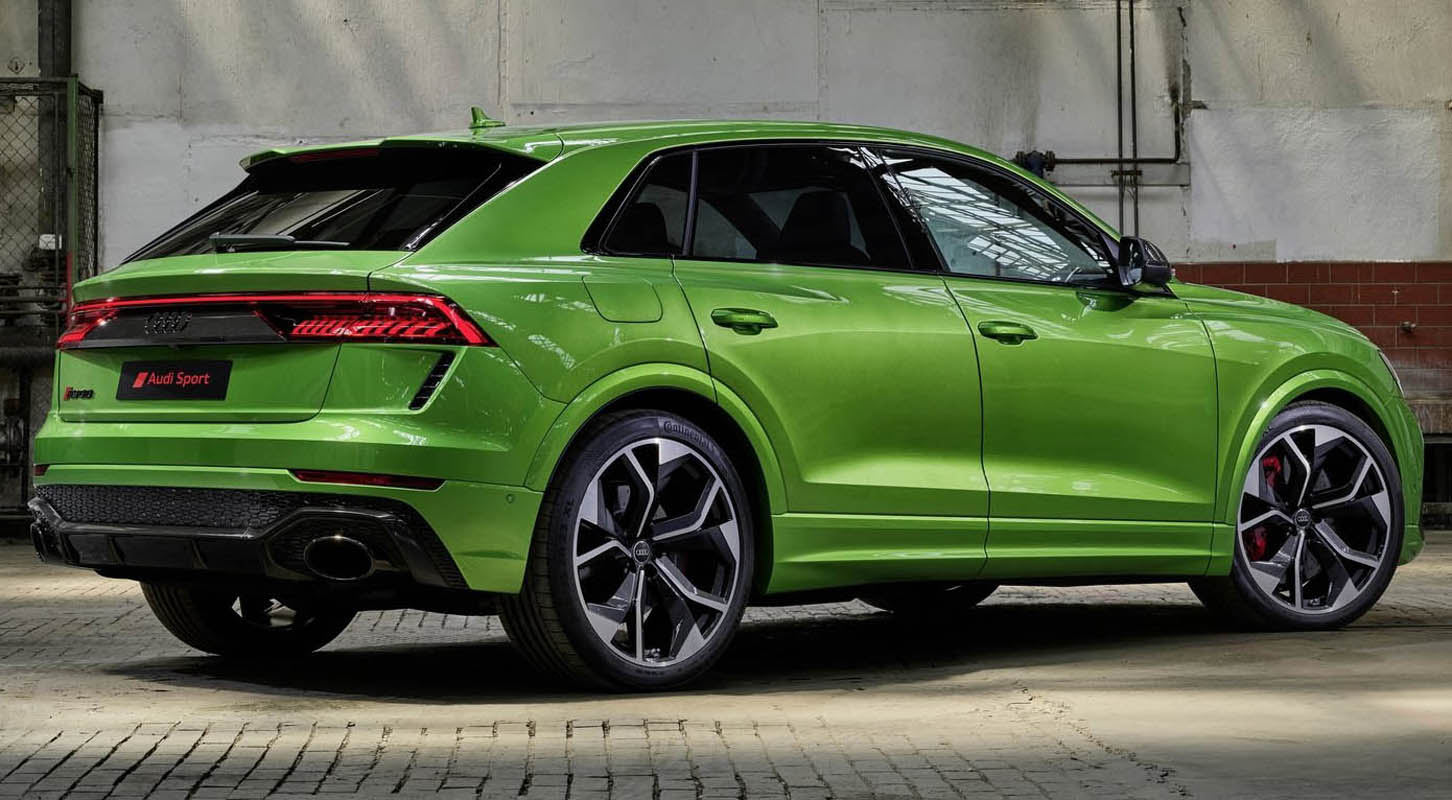
Suspension
Responsive around tight curves, composed on the highway and robust off-road: The suspension of the new RS Q8 also combines the best characteristics from various worlds. The five-link construction at the front and rear axles handle longitudinal and lateral forces separately. The linkages and the subframes are made largely of aluminum. The large SUV coupé has a track width of 1,692 millimeters (5.55 ft) up front and 1,696 millimeters (5.56 ft) at the rear.
With variable ground clearance, short overhangs, quattro permanent all-wheel drive and the hill descent control, the new Audi RS Q8 can carry on calmly and confidently when paved roads end. The standard adaptive air suspension sport with controlled damping means it is equally at home on the racetrack or an off-road trail. Its RS-specific damper tuning allows for a particularly broad spread between a setup biased toward comfort and a particularly sporty setup.
The air suspension can be adjusted to various modes with the Audi drive select dynamic handling system, varying the ride of the body by up to 90 mm (3.5 in) depending on the driving situation and the driver’s wishes. Up to a speed of 30 km/h (18.6 mph), the driver can increase the ground clearance by up to 50 mm (2.0 in). As the speed increases, the suspension automatically lowers the body gradually. This reduces the drag and serves the purpose of increasing the dynamic handling.
Above 160 km/h (99.4 mph) or if the driver selects the dynamic mode in Audi drive select, the vehicle is lowered by 40 mm (1.6 in) compared to its normal position. When the car is parked, the system can also lower the loading level by 65 mm (2.6 in) relative to the normal level.
If the driver chooses off-road mode in Audi drive select, the electronic stabilization control automatically switches to stability, traction and braking control modes that are optimized for off-road driving. The standard hill descent control system is also activated. It provides support by means of automatic brake interventions when driving down a steep gradient that exceeds six percent. The electronic chassis platform captures the tilt angle of the car and displays this information for the driver on the MMI. At off-road level, the angles of approach/departure of the new RS Q8 are 21.6 degrees at the front and 26.2 degrees at the rear.
Like driving on rails: the electromechanical active roll stabilization
The optional electromechanical roll stabilization minimizes lateral movements of the body during quick cornering. A compact electric motor and transmission are located between the two halves of the stabilizer on each of the two axles. For straight-line travel, the two halves are decoupled from each other; as a result, the wheels of an axle can move independently of each other. This reduces the sprung mass vibrations on uneven roads and, in addition, increases the ride comfort. During cornering, however, the focus is on optimum roll compensation. For this purpose, the two stabilizer halves are twisted against each other. The stabilizer thus works against the spring compression force and thus significantly reduces the lean of the vehicle when cornering. The electromechanical active roll stabilization is integrated in the 48-volt main electrical system and also works as a recuperating system. Because it can even recover power via the electric motors. This is fed back into the lithium-ion battery in the form of electrical energy.
With the optional dynamic package plus with a regulated top speed of 305 km/h (189.5 mph), the customer receives a suspension designed for maximum sportiness. It contains the electromechanical active roll stabilization, the quattro sport differential and the RS ceramic brake system.
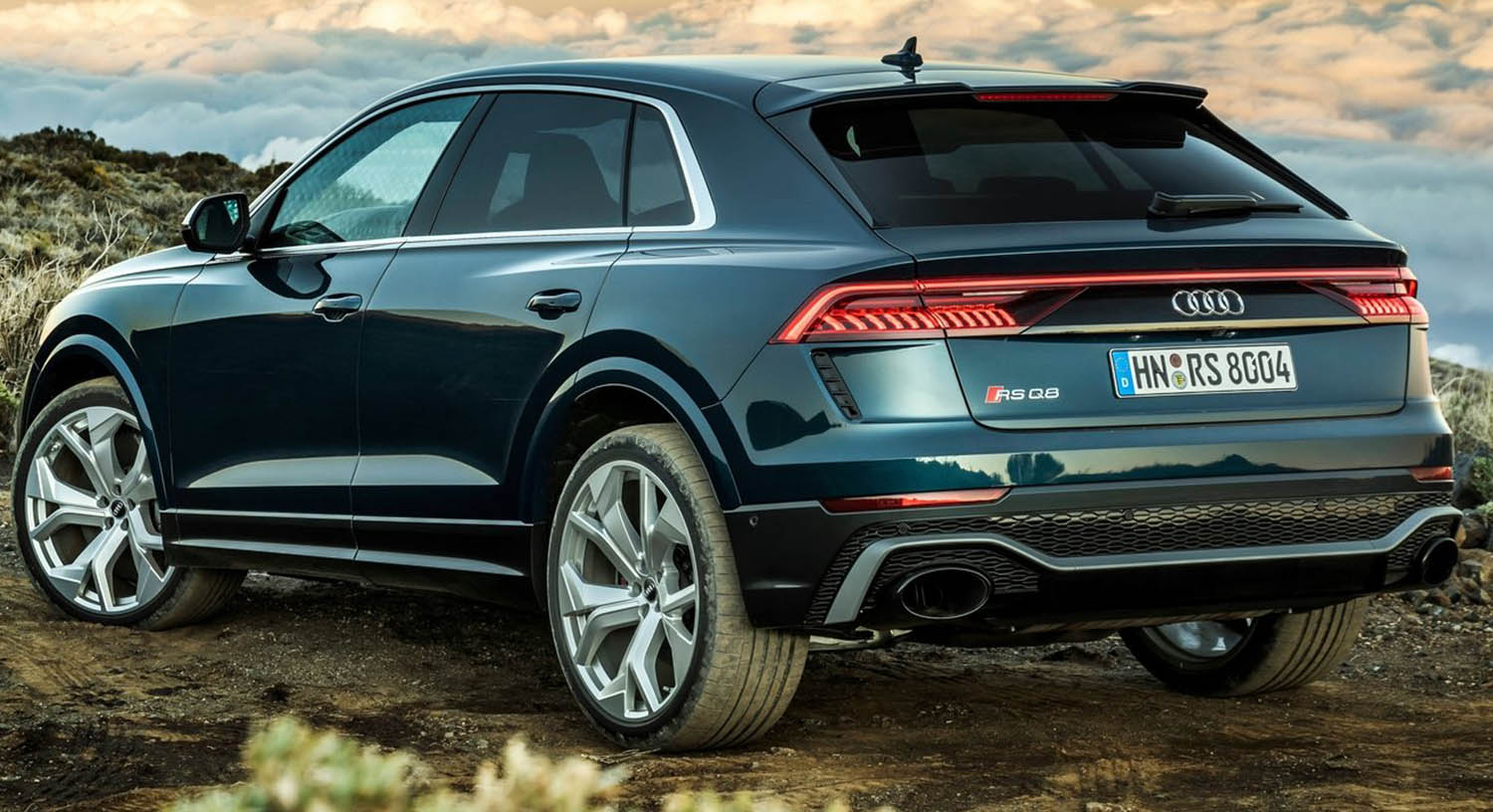
High manageability at maximum stability: standard all-wheel steering
The standard all-wheel steering moves the rear wheels of the new RS Q8 via a high-torque electric spindle drive and two track rods. At low speeds, the rear wheels turn up to 5 degrees in the opposite direction of the front wheels for greater agility and reduce the turning circle. At high speeds, they turn up to 1.5 degrees at the same steering angle as the front wheels to improve stability during fast lane changes. As a result, the rear is brought into the chosen direction
The tuning of the steering is geared to the vehicle’s use on the race track. At the front axle, the rubber/metal mounts are designed to be stiffer than those of the Audi Q8 basic model. The elasto kinematics, which are optimized for sportiness, lead to a perceptibly more direct steering response in the SUV coupé of Audi Sport. Even in the central position, the steering has a sporty and direct ratio of 13.3:1.
“RS MODE”: a button for dynamic handling
Using the Audi drive select dynamic handling system, the driver can influence the character of the RS Q8 in a targeted manner. There are eight profiles available: comfort, auto, dynamic, efficiency, all-road, off-road and the customizable, RS-specific RS1 and RS2 modes. These can be activated directly via the “RS MODE” steering wheel button. Consequently, the driver can easily switch between the RS1, RS2 and last selected drive mode without having to operate the MMI touch response again. Audi drive select affects such things as engine and transmission management, steering assistance, the air suspension, all-wheel steering, engine sound and the mode of the automatic air conditioning. In “RS2” mode, customers can also switch the Electronic Stabilization Control (ESC) to sport mode at the touch of a button and save this setting permanently. If the driver presses the ESP button for more than three seconds, the Electronic Stabilization Control is deactivated completely for driving on race tracks, for example.
Tightly networked: Electronic chassis platform
Management of all adjustable suspension systems is integrated into the control unit for the electronic chassis platform (ECP). The systems are tightly networked and work in a highly coordinated manner with maximum precision. The dampers are actuated in millisecond cycles, for example. As the central suspension controller, the ECP collects all key data about the movement of the car and about the systems involved. The integral dynamic handling controller then uses this data to compute the optimal setting of these components.
Larger wheels than ever before in a production Audi: 22 inches, with 23 inches as an option
The new Audi RS Q8 comes as standard with 22-inch aluminum wheels in a 10-spoke star design with 295/40-series tires – the largest ever to be factory-installed on an Audi model. Optional 23-inch cast aluminum wheels in a 5 Y-spoke rotor design and a variety of colors are available exclusively for the RS Q8 (with 295/35 tires).
At the front axle of the SUV coupé, a ten-piston fixed-caliper brake system delivers outstanding performance and high stability. The calipers of the standard RS brake system with internally ventilated and perforated discs (measuring 420 millimeters (16.5 in) at the front and 370 millimeters (14.6 in) at the rear) are painted black, with red available upon request.
Extremely stable and long-lasting: the RS-ceramic brake system
For the completely newly-developed, optional RS ceramic brake system, calipers are designed in gray, red or blue. The discs measure 440 millimeters (17.3 in) at the front and 370 millimeters (14.6 in) at the rear. The anthracite gray ceramic discs are particularly stable, powerful and long-lasting. Air deflector elements rapidly dissipate heat and improve stability against fading. Compared to is steel counterpart, the RS ceramic brake system is 34 kg (75.0 lb) lighter and thus reduces the unsprung masses for even better ride quality.
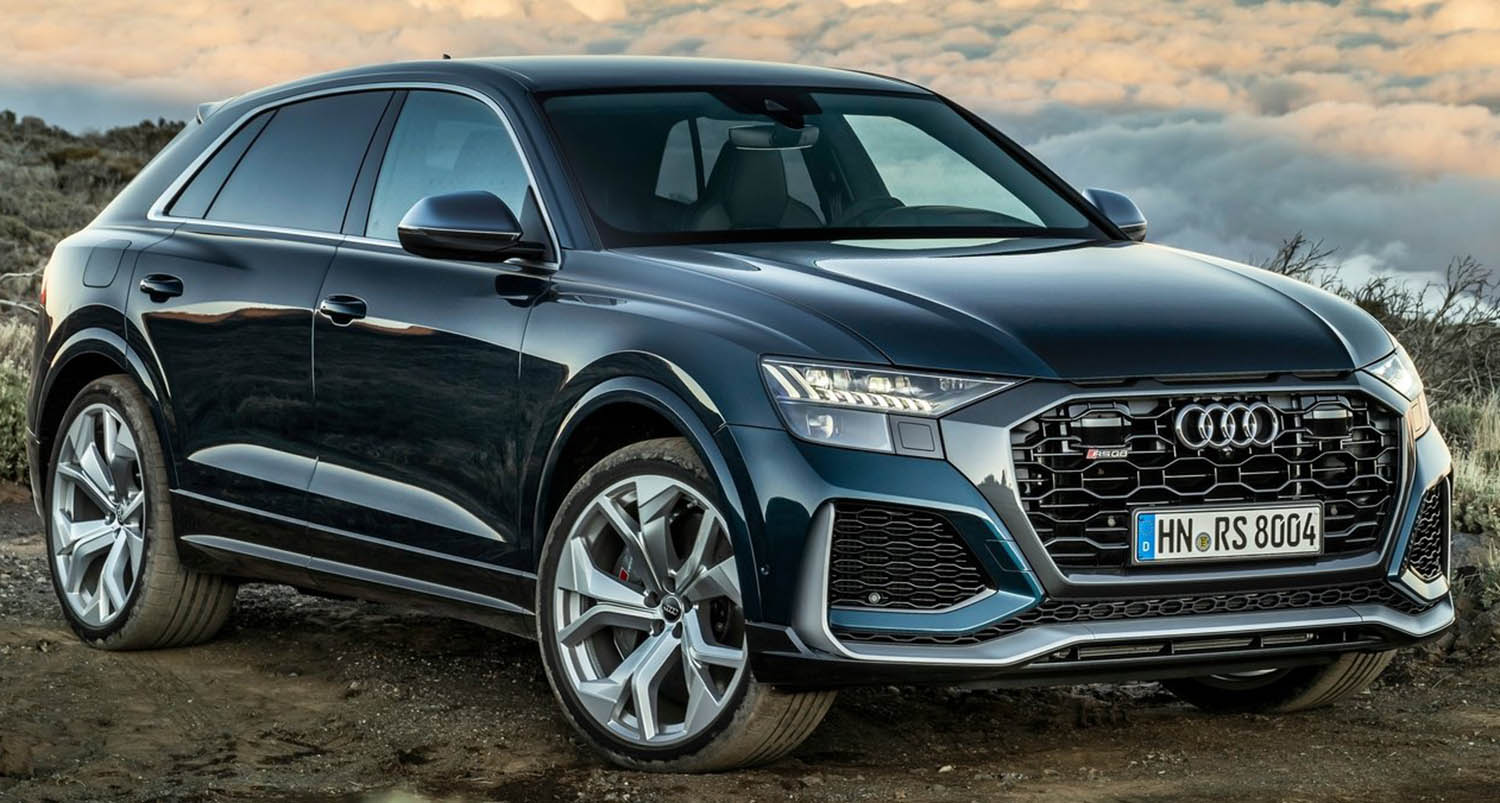
Nürburgring lap record demonstrates the quality of development work
As part of the development work, the Audi RS Q8 was tested continuously over 18,000 km (11,184.7 mi) on the Nordschleife (North Loop) of the Nürburgring. Race driver and test driver Frank Stippler achieved a new lap record for the Nordschleife for production SUVs in fall 2019. The time of 7 minutes and 42 seconds over 20.832 km (12.9 mi) proves the unique performance of the performance SUV, its enormous controllability, even at its limits, and the optimum tuning of its suspension systems.
Interior
The interior of the new RS Q8 features a deliberately clean design. All elements beneath the completely black cloth headlining have a logical connection and harmonize with one another. The headlining is optionally available in lunar silver cloth, Alcantara lunar silver or Alcantara black.
The slim instrument panel and the strongly horizontal lines convey a feeling of spaciousness. The central element in the cockpit is the top MMI touch response display. With its black-panel look, it almost dissolves into a large, black surface when switched off. Another primary design element is the wide, symmetrical console of the center tunnel. Framing it are metallic design elements in Aluminum Race, anthracite, which underscore the sporty character of the RS Q8.
Sporty luxury: RS-sport seats with ventilation
The sport seats in black pearl Nappa leather / Alcantara fit in perfectly with the athletic atmosphere of the high-performance SUV coupé. An even more luxurious option is available in the form of RS sport seats covered with Valcona leather in black or cognac, featuring a honeycomb pattern and an embossing of the RS logo. In addition to a massage function, the RS sport seats are perforated to also provide ventilation.
Detail-focused: the RS-specific interior
In the interior, the RS emblem is found on the steering wheel and on the selector lever. The illuminated front door sill trims sport an RS Q8 logo. Logo projectors on the front and rear doors beam the Audi Sport emblem onto the ground when the doors are open. The fully perforated RS sport leather steering wheel flattened at the bottom with shift paddles also integrates multifunction buttons. The driver can directly select the new Audi drive select modes RS1 and RS2 via the RS MODE button. This automatically opens the RS-specific displays in the Audi virtual cockpit.
Individual: RS design packages, inlays and expanded leather package
The two RS design packages include red or gray contrasting stitching on the knee pads, steering wheel rim, floor mats, selector lever and the edges of the seat belts. With both design packages, the center console, selector lever and RS sport leather steering wheel are designed in Alcantara. Additional choices include inlays in carbon matt, gray oak or aluminum spectrum. The extended leather package also includes the upper door panels and takes the ambiance even further upscale.
Dynamic lighting: the atmosphere LED light
The contour atmosphere lighting package in the new RS Q8 underscores the interior design in darkness and presents the space, volume and materials. The ambient light makes the dashboard and center console seem to float, and in the door it enhances the sense of space. The contour light traces the large lines on the center console and in the door panels and can be set to any of 30 colors.
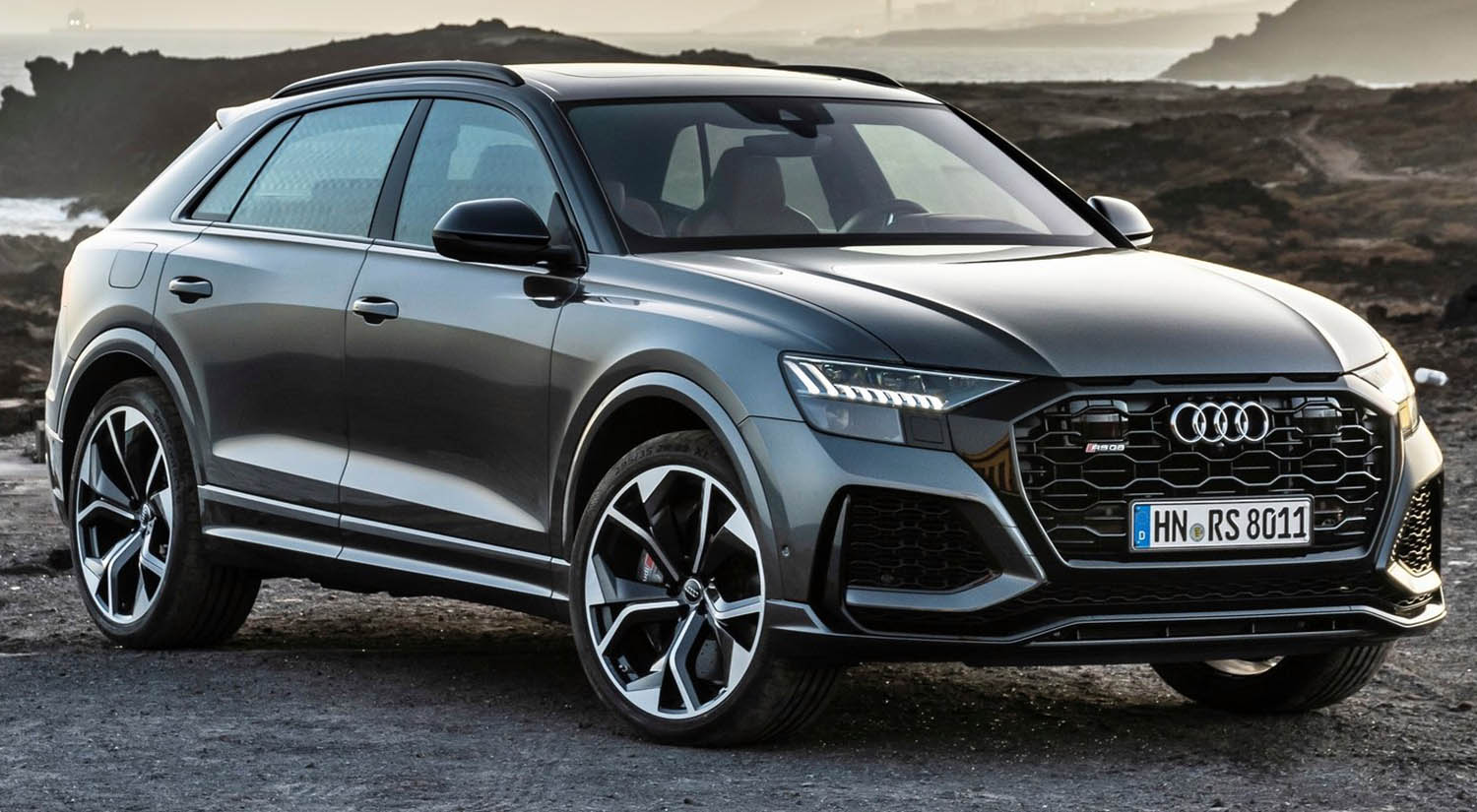
Generous: the variable space concept
With a wheelbase of 2,996 mm (118.0 in), the Audi RS Q8 offers ample space for five people. A three-seat rear bench that slides up to 10 cm (3.9 in) is standard. Large storage compartments and pockets, particularly in the doors, prepare the large SUV coupé for long trips. Together, they have a volume of more than 14 l (0.5 cu ft).
The luggage compartment of the RS Q8 has 605 l (21.4 cu ft) of space as standard; with the backrests folded down, it has up to 1,755 l (62.0 cu ft). An electric tailgate is standard; foot-activated gesture control is available as an option. The electric luggage compartment cover is another convenience option. Guided on rails, it automatically retracts when the tailgate is opened.
Control system
The RS look of the Audi virtual cockpit fits in perfectly with the Audi RS Q8. The driver can choose between the classic and infotainment view – both with red graphic details. Here too, special RS views provide information on, among other things, tire pressure, tire temperature, torque, performance, acceleration, lap times and g-forces. The shift light display prompts the driver to upshift when the rev limit is reached. On the central monitor of the interior, the driver gains an overview of the temperature status of the drive and chassis components, the maximum g-forces and information on the tire pressure and temperature via the “RS Monitor” display.
The optional head-up display projects important information onto the windshield, including detailed lane guidance for safe navigation and some RS-specific graphics.
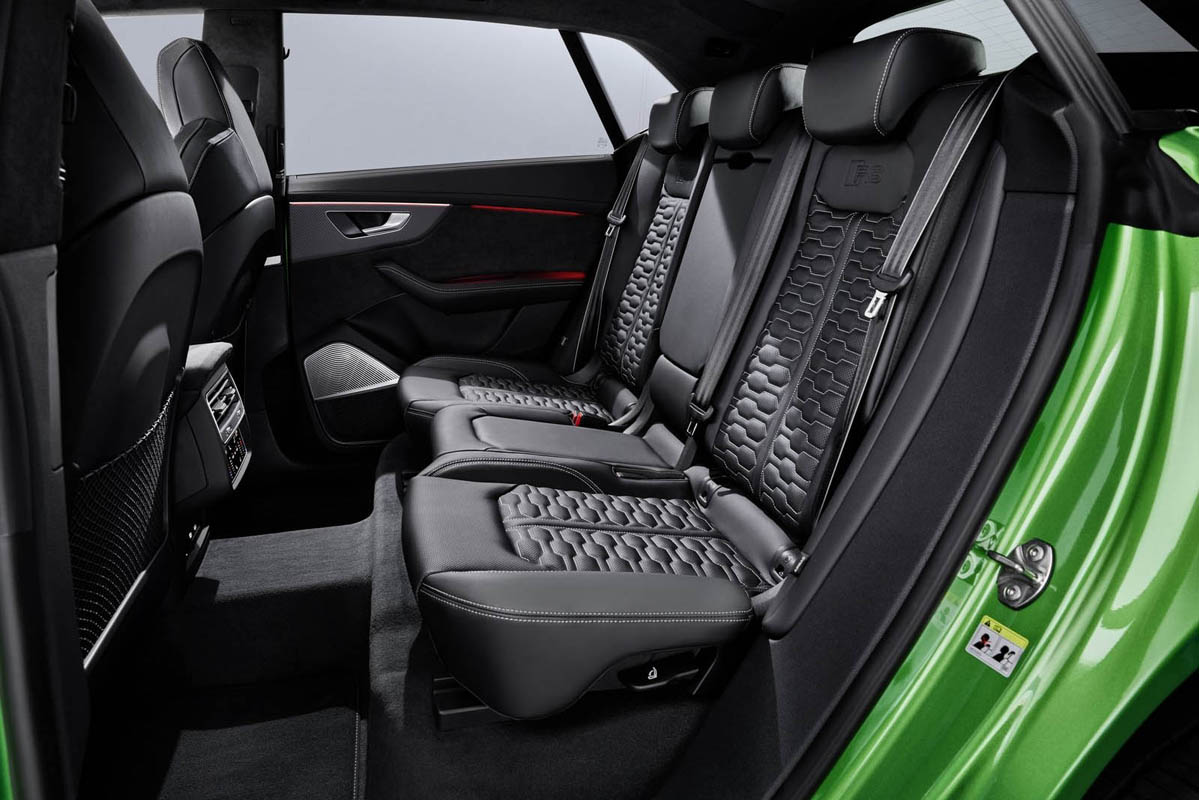
The voice control system is based on natural-language voice control. This makes the Audi RS Q8 a real conversationalist and travel companion. The user can speak freely for the most part. The voice control can, for example, understand the sentence “I am hungry” and in response suggests restaurants close by.
Infotainment and Audi connect
Audi equips the RS Q8 with a comprehensive range of infotainment and connectivity features. The vanguard of the Q family comes standard with the top infotainment system, MMI navigation plus with integrated Audi connect data transfer module. This brings not just the Wi-Fi hotspot but also the fast LTE Advanced communication standard to the car. It allows data download rates of up to 300 Mbit/s and upload rates of up to 50 Mbit/s. The module provides the Audi connect services in virtually all European countries via a SIM card permanently installed in the vehicle. All these systems are based on the latest-generation Modular Infotainment Platform, the MIB 2+.
A step ahead: the navigation
When planning the route, the self-learning navigation system makes suggestions to the driver based on routes driven previously, incorporating experiences regarding time of day and traffic density. The route is calculated online on the servers of the map and navigation service provider HERE, which also considers real-time data concerning the overall traffic situation. If the data connection is lost while the car is on the move, the navigation system will switch to on-board route guidance, which runs in the background.
The map with updated graphics includes detailed 3D models of many major cities in Europe. An expanded point-of-interest display allows drivers to access to such places as gas stations and parking garages while navigation is active, supplemented with additional information such as fuel prices, number of available parking spaces or operating hours. The customer can load four free card updates per year – even over-the-air in combination with Audi connect.
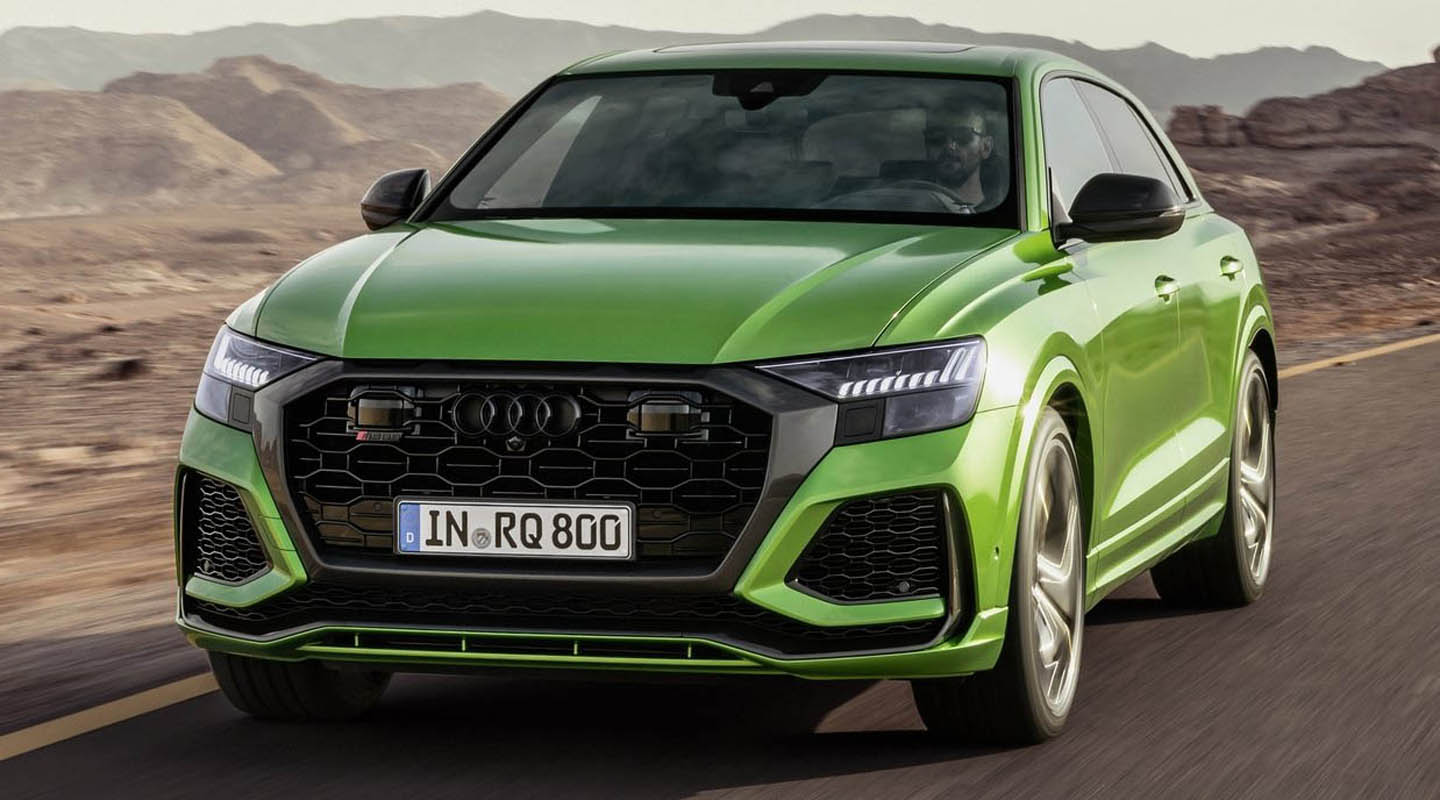
Well-informed and entertained: connect services and auditory experience
The Audi connect online services, which are likewise free of charge in the first three years, supplement navigation with predictive elements. This is particularly true for the Car-to-X services traffic sign information and hazard alerts, which use the swarm intelligence of the Audi fleet.
Audi connectalso offers many other services, such as media streaming, online news and navigation with Google Earth. Access to Twitter, email and hybrid radio is also included. With the latter, the radio automatically switches between FM, DAB and the online stream depending on the signal strength to ensure optimal reception at all times.
The functions of Audi connect emergency call and service form their own package. In many markets, the data traffic for all connect services goes through the Audi connect SIM, which is permanently installed in the car. Using the myAudi app, owners of the new Audi RS Q8 gain access to the brand’s digital ecosystem.
The optional Audi connect key provides digital access to the RS Q8. It allows the owner and four additional drivers to lock and unlock the car and start the engine using their Android smartphone. They can store their preferred settings in individual profiles using the standard personalization function. Up to 400 parameters can be entered, from air conditioning settings and seat adjustments to navigation destinations and media. The car identifies the respective user from the signal in the remote control key or Audi connect key as soon as the automobile is unlocked and activates their profile.
Telephony in the Audi RS Q8 is top-notch with respect to operation, sound and connection quality. The Audi phone box connects the smartphone to the vehicle’s antenna and charges the phone inductively. Another function, Voice-over-LTE, helps to connect faster and makes it possible to use high-speed data transfer and high-resolution online voice telephony at the same time. The Audi smartphone interface connects to customers’ iOS and Android cell phones – in the future even wirelessly in the case of the iPhone – and places their Apple Car Play or Android Auto environment on the MMI display.
To play music from an MP3 player, USB stick or smartphone through the car’s loudspeakers, the RS Q8 has two USB ports under the center armrest as well as two optional USB ports in the rear, all of which also include a charging function. The Bang & Olufsen Advanced Sound System with 23 speakers brings 3D sound with its information to the front seats as well as to the rear. The music unfolds exactly how it was recorded at the concert hall – a fascinating listening experience.
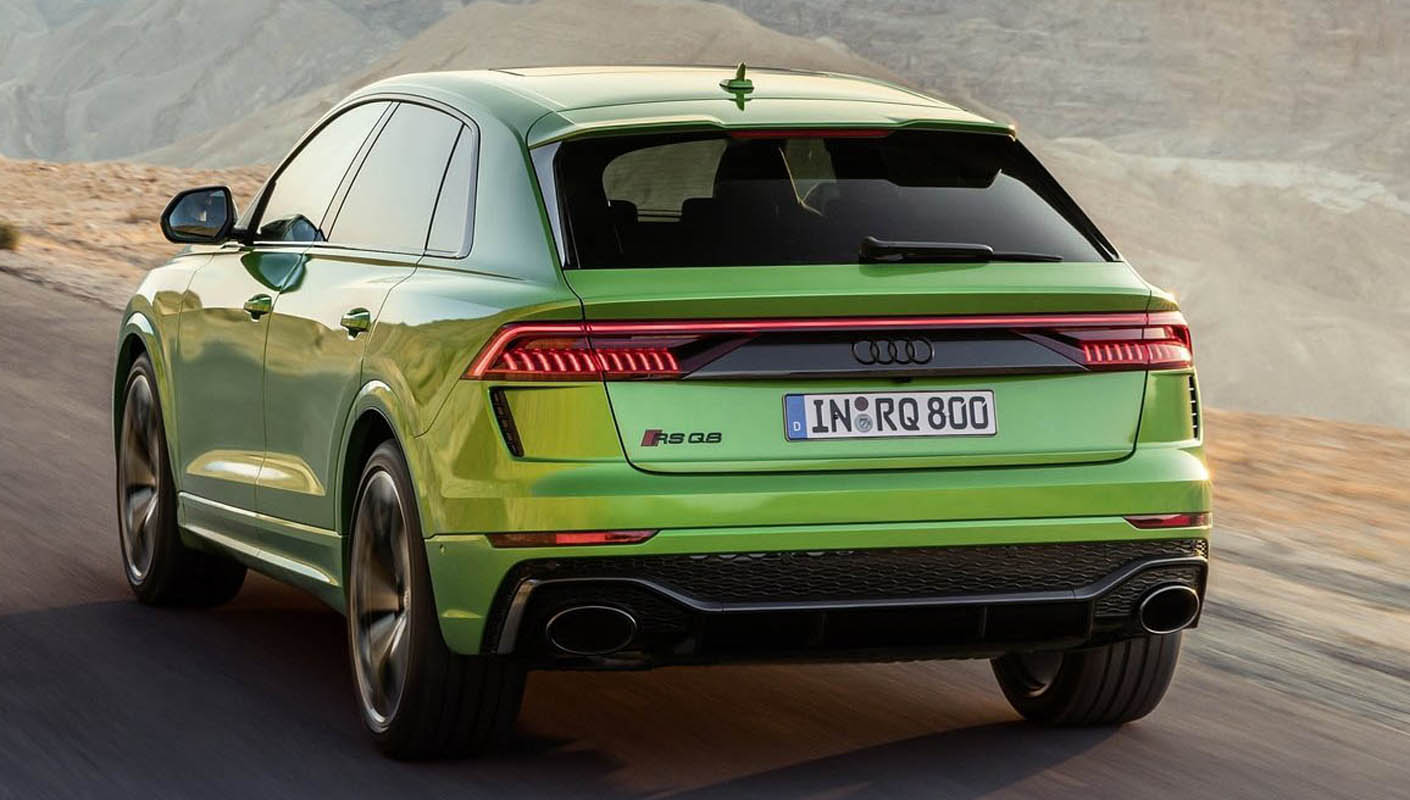
Driver assist systems
The wide selection of available assist systems makes your drive in the RS Q8 as relaxing and safe as possible. Some of these, including the safety systems Audi pre sense basic and Audi pre sense front – are standard equipment. The camera-based traffic sign recognition is also part of the scope of delivery in Germany. The most important optional systems are subdivided into the “City” and “Tour” packages.
The adaptive cruise assist (AFA) relieves the driver on longer journeys by assisting with longitudinal and lateral guidance. It incorporates the functions of adaptive cruise control, traffic jam assist and active lane assist. In conjunction with the efficiency assist, the system predictively slows down and accelerates the Audi RS Q8 on the basis of sensor information, navigation data and road signs.
The collision avoidance assist, intersection assist, rear cross-traffic assist, exit warning and lane change assist ensure safety when driving in the city. Multiple images from the surround view cameras allow precise maneuvering down to the centimeter and provide a view of cross traffic and a detailed view of the wheels. One of its highlights is the 3D view with freely selectable perspective.
